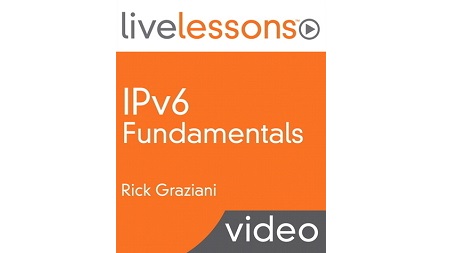
English | MP4 | AVC 1280×720 | AAC 44KHz 2ch | 6h 29m | 2.73 GB
Learn about IPv6 addressing and address types, dynamic IPv6 address assignment using SLAAC, stateless DHCPv6 and stateful DHCPv6, DHCPv6 prefix delegation, ICMPv6 Neighbor Discovery, and routing IPv6 using EIGRP for IPv6 and OSPFv3, including named EIGRP and OSPFv3 address families.
IPv6 can be challenging for everyone, from CCNA students to seasoned network engineers. The transition to IPv6 has begun, mostly due to the long-anticipated problem of IPv4 address exhaustion. The lessons in this video give you a strong foundation in understanding the IPv6 protocol, including IPv6 addressing and address types; dynamic IPv6 address assignment using SLAAC; stateless DHCPv6 and stateful DHCPv6; ICMPv6 Neighbor Discovery; address resolution; and routing IPv6 using EIGRP for IPv6 and OSPFv3, including named EIGRP and OSPFv3 address families. Using the information in this video, you will understand how IPv6 is implemented in a network. The author provides a series of short instructional videos that clearly explain these and other IPv6 topics. These videos will help those already familiar with IPv4 become confident in their understanding and implementation of IPv6.
What You Will Learn
- The reasons for the transition to IPv6 and a brief history of its development
- A comparison between the IPv4 and IPv6 protocols
- IPv6 addressing in depth (and how it differs from IPv4) including global unicast, link-local unicast and multicast addresses
- Stateless address autoconfiguration (SLAAC), stateless DHCPv6, stateful DHCPv6, and DHCPv6-PD (Prefix Delegation)
- ICMPv6 Neighbor Discovery including address resolution and duplicate address detection
- IPv6 configuration options for Cisco routers and hosts
- IPv6 routing protocols including EIGRP for IPv6, Named EIGRP, and OSPFv3 and OSPFv3 address families
- Understanding the IPv6 routing table and defining static IPv6 routes
Table of Contents
01 IPv6 Fundamentals LiveLessons – Introduction
02 Learning Objectives
03 1.1 Beginning with IPv4
04 1.2 Introducing IPv6
05 1.3 The Need for IPv6
06 1.4 Transitioning to IPv6
07 Learning Objectives
08 2.1 Comparing the IPv4 and IPv6 Headers
09 2.2 A Brief Look at IPv6 Address Types
10 2.3 A Brief Look at ICMPv6 Neighbor Discovery
11 Learning Objective
12 3.1 Understanding Hexadecimal Numbers
13 3.2 Representing an IPv6 Address
14 3.3 The IPv6 Prefix Length
15 3.4 Overview of IPv6 Address Types
16 Learning Objectives
17 4.1 Purpose and Format of GUA
18 4.2 Subnetting IPv6
19 4.3 IPv6 Address Allocation
20 4.4 Configuring a Static GUA
21 4.5 Configuring a Static GUA with EUI-64
22 4.6 Overview of Dynamic IPv6 Address Allocation (SLAAC and DHCPv6)
23 Learning Objectives
24 5.1 Purpose and Format of Link-Local Addresses
25 5.2 Automatically Created Link-Local Addresses
26 5.3 Manually Created Link-Local Addresses
27 5.4 Verifying Link-Local Addresses
28 Learning Objectives
29 6.1 Purpose and Format of IPv6 Multicast Addresses
30 6.2 Introducing IPv6 Solicited-Node Multicast Addresses
31 6.3 IPv6 Solicited-Node Multicast Advantages and Ethernet
32 6.4 IPv6 Solicited-Node Multicast Example
33 6.5 Mapping IPv6 Multicast to Ethernet Multicast
34 6.6 Multicast Listener Discovery
35 Learning Objectives
36 7.1 Introduction to SLAAC and ICMPv6 ND
37 7.2 Creating the Interface ID – EUI-64 or Random Value
38 7.3 Configuring a Router as a SLAAC Client
39 7.4 IPv6 Enabled Clients and Your Network
40 Learning Objectives
41 8.1 Router Advertisement and DHCPv6
42 8.2 Stateless DHCPv6
43 8.3 Stateful DHCPv6
44 8.4 DHCPv6 Relay
45 8.5 DHCPv6 Prefix Delegation Process
46 8.6 DHCPv6-PD Configuration Example
47 8.7 Verifying DHCPv6-PD
48 Learning Objectives
49 9.1 ICMPv6 Messages
50 9.2 ICMPv6 Error Messages
51 9.3 ICMPv6 Informational Messages – Echo Request and Echo Reply
52 Learning Objectives
53 10.1 Introducing ICMPv6 Neighbor Discovery
54 10.2 Router Solicitation and Router Advertisement Messages
55 10.3 Neighbor Solicitation and Neighbor Advertisement Messages
56 10.4 Neighbor Cache
57 Learning Objectives
58 11.1 Enabling the IPv6 Router
59 11.2 IPv6 Routing Table
60 11.3 IPv6 Static Routes
61 11.4 IPv6 Summary Static Routes
62 11.5 IPv6 Default Static Route
63 Learning Objectives
64 12.1 Protocol and Concepts
65 12.2 Classic EIGRP for IPv6
66 12.3 Named EIGRP Configuration
67 12.4 EIGRP Configurations at a Glance
68 Learning Objectives
69 13.1 Protocol and Concepts
70 13.2 OSPFv2 and Traditional OSPFv3
71 13.3 OSPFv3 Address Families
72 13.4 OSPFv3 Address Families—IPv4 Island
73 13.5 OSPF Configurations at a Glance
74 IPv6 Fundamentals LiveLessons – Summary
Resolve the captcha to access the links!